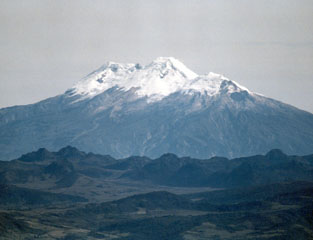Report on Nevado del Huila (Colombia) — 30 April-6 May 2008
Smithsonian Institution / US Geological Survey
Weekly Volcanic Activity Report, 30 April-6 May 2008
Managing Editor: Sally Sennert.
Please cite this report as:
Global Volcanism Program, 2008. Report on Nevado del Huila (Colombia) (Sennert, S, ed.). Weekly Volcanic Activity Report, 30 April-6 May 2008. Smithsonian Institution and US Geological Survey.
Nevado del Huila
Colombia
2.93°N, 76.03°W; summit elev. 5364 m
All times are local (unless otherwise noted)
INGEOMINAS reported that no significant morphological changes to the summit of Nevado del Huila were noted during an overflight on 6 May, although the NE and NW flanks could not be directly observed. Fumarolic plumes drifted NW. The Alert Level was lowered to Yellow (on a 4-color scale where Yellow is the second lowest).
Geological Summary. Nevado del Huila, the highest peak in the Colombian Andes, is an elongated N-S-trending volcanic chain mantled by a glacier icecap. The andesitic-dacitic volcano was constructed within a 10-km-wide caldera. Volcanism at Nevado del Huila has produced six volcanic cones whose ages in general migrated from south to north. The high point of the complex is Pico Central. Two glacier-free lava domes lie at the southern end of the volcanic complex. The first historical activity was an explosive eruption in the mid-16th century. Long-term, persistent steam columns had risen from Pico Central prior to the next eruption in 2007, when explosive activity was accompanied by damaging mudflows.

